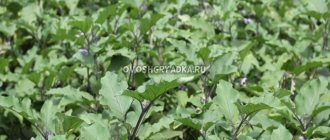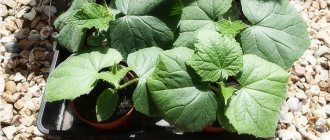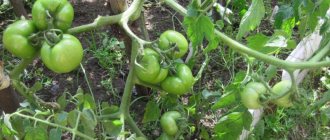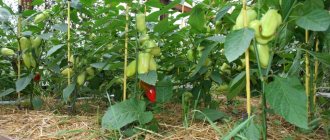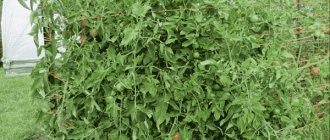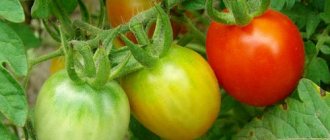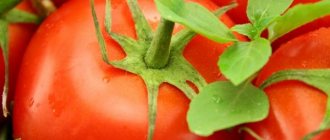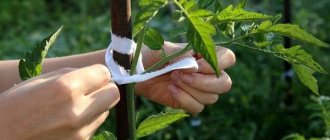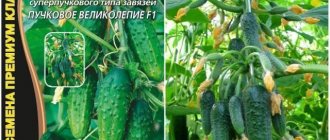Author's rating
Author of the article
Yakov Pavlovich
Professor, Head of the Department of Vegetable Growing
Articles written
153
To get a high yield of tomatoes, most gardeners use a technique called pinching. More often you can hear the name formation of a tomato bush. In the axils of the leaves there is an additional shoot - a stepson. If it is not removed, plants with a large volume of greenery will develop in the garden bed. Along with this, there will be few brushes and set fruits.
Why do tomato bushes form?
In fact, gardeners take the first step in shaping tomatoes while planting seedlings. Even if the root is not specifically pinched, it breaks off on its own and becomes a little shorter. This gives impetus to the formation of lateral sucking processes, allowing for better absorption of moisture and nutrients from the upper layers of the soil.
Forming tomatoes consists of several operations:
- stepsoning;
- rationing of flower brushes;
- removing excess leaves;
- finishing;
- guiding and gartering the stem.
In raceme varieties, rationing can be carried out, but fruit clusters are not pinched. Both operations are not recommended for cherry tomatoes. To grow record-breaking fruits, rationing and pinching of clusters is mandatory.
All shaping procedures are interconnected and have a single goal - obtaining a high yield of quality tomatoes. Otherwise bush:
- increases green mass to the detriment of fruiting;
- thickens, as a result of which it is poorly ventilated and often gets sick;
- shoots and leaves shade each other and the ovaries, which interferes with photosynthesis;
- requires increased watering and fertilizing;
- the root system is not able to provide nutrition to the entire above-ground part;
- tomatoes bloom profusely, but the fruits set poorly, take a long time to ripen, and grow much smaller than indicated in the description of the variety;
- on tall bushes only the lower clusters have time to ripen.
Formation of tomatoes in open ground and greenhouses allows:
- get a larger harvest;
- improve the commercial and consumer qualities of fruits, including taste, size and sugar content;
- redistribute nutrients and plastic substances, directing them towards the formation and maturation of ovaries, and not the growth of green mass;
- lighten the bush;
- reduce the likelihood of fungal, viral and bacterial infections;
- simplify treatments against pests and diseases;
- remove useless shoots that do not produce a harvest, but only consume nutrients;
- accelerate fruit ripening by about 5-7 days;
- reduce the amount of watering and fertilizing;
- make care easier;
- save space in the garden bed, greenhouse or greenhouse.
When and how tomatoes are formed
The first pinching is carried out 14 days after placing the seedlings in open ground or a greenhouse. During this period, the tomatoes have time to take root and begin to grow actively.
If the crop is planted in a greenhouse, the formation of tomatoes is carried out in early June. A side shoot appears in the axil of each leaf. It is he who needs to be eliminated. This procedure is carried out using pruners or manually. To prevent new ones from appearing in the place of the removed stepson, you should leave stumps up to 1 cm long.
The formation of tomatoes begins in the morning. Choose a sunny day. By evening, the cut area will be able to dry out, and the crop will endure the procedure without stress. You need to get rid of stepchildren every week or two. You also need to ensure that the length of each shoot is not more than 7 cm.
The height of the tomatoes will tell you how to form the bushes. For example, if the plant is tall and shoot growth is unlimited, leave one main stem in the center. Up to 7 clusters of tomatoes are formed on it. Medium and low-growing specimens are formed into a bush, leaving two or three stems.
To obtain large mature units, the process of culture formation should not be completed with one stepson. Each stem should contain 3-5 flower clusters. The rest are subject to elimination. To stop upward growth, pinch the top of the plant so that two leaves rise above it.
As the crop grows, it is tied to a support or trellises are installed. This option is optimal for tall species. Another important point in the procedure for forming tomato bushes is pruning the leaves. Experienced gardeners argue about the appropriateness of this measure. Most insist that by removing leaves at a height of 30 cm, the problem of late blight can be avoided.
Depending on growing conditions
The formation of tomato bushes has its own peculiarities. For example, in the conditions of growing plants in open ground and in a greenhouse, there are some differences.
Greenhouse
To avoid negative situations, cultivation of crops in protected soil is carried out, observing certain features. Basically, they adhere to the following rule: 5-6 clusters with fruits remain on the bushes. It is possible to achieve such a result with the help of stepsoning.
The following rules for plant formation should be adhered to when cultivating crops in a polycarbonate greenhouse:
- it is necessary to form stems at the stage when the culture begins to develop intensively;
- shoots are removed so that a small stump remains.
See also Dutch variety Torbay f1: characteristics and yield of tomato
To achieve optimal results, nutrition should be concentrated on one stem, which will be the main one. Along with the formation of bushes, diagonal suspension is carried out. Thus, the harvest can be obtained 14 days earlier. By increasing the fruiting period, productivity increases.
Open ground
To form a culture in the conditions of growing tomatoes in open ground, adhere to the following scheme:
- No more than five flowers are left on the main stem, two of which should be shoots.
- After the main shoot stops growing, the bush will begin to develop further thanks to the stepchildren left in a timely manner.
- If brushes have grown on the shoots during this time, they are torn off. Leave one or two.
- The shoot that emerged from the axil of one of the leaves on the main stepson should be left.
- At the moment when two inflorescences have appeared on the shoot, a pinch is made over three leaves.
Several leaves must be left on top of each stem. Thanks to this measure, it is possible to grow the crop correctly, especially with regard to the adequate nutrition of the fruit.
Depending on the variety
There are several types of tomatoes that have individual biological properties. Cultures of different types will have features of formation.
Indeterminate
Tall crops require a special approach when planting. Thus, the main stem is not limited in growth. The flowering of the variety begins after 9 to 12 leaves have appeared on the plant. After every third leaf, another flower brush is laid.
If a warm climate prevails in the region or the crop is cultivated in greenhouse conditions (with a heating system), the tomato can bear fruit all year round, producing 40-50 bunches. Indeterminate species need to eliminate all existing shoots. Formation occurs in one stem. Carrying out the procedure in two stems in this situation is not advisable.
In the southern regions of the country, the variety is suitable for cultivation in open ground or greenhouses. The basic rule is that the crop must be tied to a support or grown on a trellis. In the middle zone, it is recommended to plant tomatoes of indeterminate varieties in a greenhouse. For the northern regions, the species is considered unsuitable, even in greenhouse growing conditions. The fruits do not have time to ripen.
Semi-determinant
Semi-determinate varieties are optimally formed into two stems. The strongest and most capable of surviving stepson appears under the first hand. It is highly likely to produce good results. A second stem is formed from it. 2 brushes are formed on the side shoot, and 3 on the main shoot.
It is worth forming a harvest by resorting to additional means. The first two clusters are thinned out, leaving 3 fruits. The rest are formed into 6 tomatoes. The gnarled ovary must be eliminated.
To prevent stopping the growth of the top of the crop from negatively affecting the amount of harvest, reserve shoots are left in reserve. They need to be removed when new stepsons appear.
Stepchildren are removed once they reach a length of 5 cm once every 10 days. This is easier to do by breaking off the shoots. This way the damaged area will heal as quickly as possible. If the procedure is carried out less frequently, over time it will be difficult to discern what exactly needs to be removed. Trimming or breaking off large shoots can damage the stem.
Determinant
Determinate species grow to a certain height. The first flower brush is formed at the level of the 5th leaf. The rest of the brushes appear after 1 or two. When 4 clusters appear, this type of tomato forms a cluster at the top. From this moment on, the upward growth of culture stops.
Next, the bush develops on lateral shoots, the growth of which also stops with the development of the brush.
The variety is characterized by earlier ripening of tomatoes. At the same time, it cannot be called high-yielding. The determinate species requires pinching and shaping.
Expert opinion
Stanislav Pavlovich
Gardener with 17 years of experience and our expert
Ask a Question
Attention! It is convenient to form plants of this species into two stems. Such a measure, correctly implemented, will ensure a high yield.
Determinate tomatoes are grown in open soil in the southern and middle parts of the country. In the north, the crop can be planted in a greenhouse. The fruits are heavy, so the plant requires a garter.
Superdeterminant
This variety of tomatoes includes low-growing and early varieties. Such plants do not produce a high yield, since they form only three inflorescences on one stem. Superdeterminate varieties do not require pinching. However, it is still carried out in order to obtain the maximum number of fruits.
The variety is formed as follows:
- In two stems. It is considered the best option for the formation of these varieties. Suitable for tomatoes grown outdoors. In addition to the main stem, there remains one stepson below, which appears first. This formation of the bushes allows you to get a small number of large fruits.
- Three stems. Suitable for plants grown in a greenhouse. The main stem and two stepsons extending from it are left on the bushes. This way you can get three bunches of fruit.
Standard
Standard varieties are undemanding to care. These are low-growing plants with powerful stems. They do not require garters or stepsons. The first cluster with inflorescences appears after 5 leaves, then after 2.
What varieties need to be formed
There is no single correct way to properly form tomatoes of all varieties. This depends on the following factors:
- the nature of the growth of the bush - the taller the tomato, the more shaping it needs;
- method and place of cultivation - there are specific features of the operation for open and protected ground;
- owner's skills - nothing is simpler than forming tomatoes into one stem, but if you leave 3 or 4, even an experienced gardener can make a mistake.
Now it is necessary to determine whether a variety or hybrid belongs to one or another variety based on the height of the tomato and the ability to independently limit growth. The number of internodes (leaves) before the formation of the first cluster is no longer always the determining indicator.
Breeders try to develop varieties that set fruit as early as possible. This speeds up ripening and saves space. One way is to force a cluster of flowers to appear an internode or two below.
Considering that tomatoes in a polycarbonate greenhouse necessarily form and grow much higher than in open ground, some practitioners generally tend to divide them into only two categories. Indeterminate - with unlimited growth, and determinate, in which the crown stops stretching upward after the formation of a certain number of brushes.
Standard
This is a variety of super-determinate tomato that does not require shaping. Varieties and hybrids produce 2-3 clusters on the main shoot; the main crop is harvested from the stepsons.
Only the side shoots and the lowest leaves extending from the ground level are removed so that they do not lie on the ground. Otherwise, the bush will become easy prey for pathogens and pests in the soil.
Superdeterminant
In open ground they grow as is; only the vegetative organs indicated for standard varieties are removed. The formation of a bush in a greenhouse is required - it is carried out in 3 or 4 trunks.
Superdeterminate varieties are rarely grown in protected soil, since they have low yields and only take up space. Usually several bushes are planted there to get early fruits for their own consumption.
Determinant
For these varieties, the formation of a tomato bush in a greenhouse and in open beds is different. In the ground they are grown in 2-3 stems. Sometimes they don’t even tie it up, which is a significant mistake. Greenhouse tomatoes grow much higher, often 1.5 or 2 times, than in the ground.
It is recommended to leave them with 1, maximum 2 stems. Experienced gardeners point out that growing 3 trunks significantly complicates shaping and care, and does not increase productivity.
Determinate tomatoes need pinching, removal of leaves, garters; to obtain large fruits, the clusters are normalized. Topping is usually not carried out.
Semi-determinant
Semi-determinate varieties can be sold as determinate or indeterminate, especially if the seeds are packaged by small companies or hobbyists. They differ from the first ones in the height and number of fruit clusters - there are not 5-6, but 8-10. They are usually formed as indeterminate ones.
It is not recommended to grow such varieties in open ground. The conditions in Russia allow the lower clusters to ripen; the rest remain green or are just beginning to bloom with the onset of cold weather. Considering that semi-determinate varieties are usually late or mid-late, it simply does not make sense to plant them in open beds. In addition, it is quite difficult to form and maintain a tall bush there.
Semi-determinate varieties are tied up, pinched, and the lower leaves are removed. Rationing of ovaries is at the request of the gardener. Topping in the ground is mandatory. In the greenhouse it depends on whether all 8-10 clusters have time to ripen.
You can calculate whether you need to pinch the top. From the moment the cluster forms until the fruit ripens, at least 1.5 months pass. When it gets cold enough in the greenhouse to end the season, the gardener knows. This is what you should focus on.
Indeterminate
These varieties are planted only in protected soil. The formation of indeterminate tomatoes is carried out in 1 stem, unless otherwise indicated in the varietal description. They need finishing.
Those gardeners who tried to grow bushes with 2-3 stems usually leave one the next year. Several trunks add trouble, reduce the usable area, but do not increase the yield.
Indeterminate tomatoes are formed in the same way as semi-determinate ones. Only finishing is required.
Formation of indeterminate varieties of tomatoes in a greenhouse
These varieties were created for heated greenhouses, where they were grown all year round. In an unheated greenhouse, of course, it is difficult to use the full potential of indeterminate varieties, but growing 5-6 racemes is quite possible. To do this, towards the end of the growing season (in the middle zone this is August 10-15), remove the top and all unset inflorescences from indeterminate varieties, let the plant “focus” on the already set fruits.
Stopping the growth of tomato bushes of indeterminate varieties
These tomatoes have unlimited growth - if it were summer all year round, they would continue to grow indefinitely.
They are formed into one stem and nothing else. There is no point in leaving the side shoots - by the time they grow and bloom (and they lay flower clusters very high), summer will already be over. You still won’t get fruit from them, and they will take a lot of energy from the plant.
The main difference in the formation of such varieties is the number of fruit clusters.
Removing stepchildren
Pruning begins no earlier than the first brush blooms. Experts advise doing this about 2 weeks after planting the seedlings, so that the tomato has time to take root and easily survive the operation.
You can remove the lateral processes with scissors or your hands - it doesn’t matter. It is important that it does not outgrow. The sooner the stepson is removed, the better.
Removing stems of 10 cm or more is necessary, but is already a stress factor for the crop. Even busy gardeners are recommended to pruning once a week. Or choose varieties that produce few side shoots.
If the bush is led into several trunks, a stepson formed under the first flower cluster is left. For the second and third (if necessary) - through several internodes. But they should also be located under, not above, the brush.
Redirecting the growth point
There are tall tomatoes that produce maximum yield only when the growing point is moved to a side shoot. This is usually indicated in the varietal description. As a replacement, leave a stepson under the lower flower brush.
It is recommended to allow 1-2 more ovaries to form on the main stem and only then carry out the topping. The selected stepson is treated as if it were the main stem - they are tied up, side shoots are removed, and, if necessary, growth is limited at the end of the season.
Features of the formation of a tomato bush in open ground
The formation of a tomato bush when grown in open ground is carried out taking into account the climatic conditions of growth. Agricultural cultivation technology is developed in each specific case in such a way that each stepson and leaf ensures the formation of a sufficient number of flower clusters with the subsequent setting of fruits on them as productively as possible.
The required feeding area, agrotechnical growing methods and methods of tomato formation are determined based on:
- per variety;
- type of bush;
- degree of branching (formation of stepsons).
The larger the feeding area, the more side shoots develop on the plant, and vice versa. Their quantity for the same nutrient area can vary significantly depending on the variety.
| 2nd order | 5-15 |
| 3rd order | 12-40 |
| 4th order | 2-15 |
Advice! It is recommended to begin taking measures to form tomato bushes from the moment the seedlings are planted in the ground.
Removing the lower leaves
After the fruit cluster is formed and begins to fill, it is recommended to remove the leaves underneath it. This will speed up the ripening of tomatoes and improve ventilation of the bush.
Previously, the lower leaves served as a source of nutrition and plastic substances for tomatoes, but they managed to fulfill their function and only get in the way. They require fertilizers and moisture, and no longer participate in photosynthesis. With the removal of the plates, the bush becomes more resistant to drought.
As the next brushes are poured, the leaves underneath are also trimmed or torn off. But sometimes, especially in hot summers, the plates shade the fruits and prevent them from “baking.” Then the leaves protecting the tomatoes are left in whole or in part. You can trim one or more segments.
In order for the tomato to develop normally, all leaves cannot be removed. On a tall bush there should be at least 25-30 of them.
In tomato varieties that do not require pinching, the lower leaves under the cluster that has begun to fill are usually not removed. But if the bush is formed correctly and the lower plates are still removed, it will be better ventilated, which will reduce the likelihood of infection. And the fruits will receive more light. This will increase their sugar content and allow them to grow larger.
Let the soil dry out a little before removing the leaves. Watering is carried out no earlier than one day after cutting the plates. This will prevent the fruits from cracking.
Removing leaves when forming a tomato bush: why should this be done?
Another very important point for obtaining a good and high-quality harvest is removing leaves. Regularly, at the same time as pruning, thin out the bushes and remove leaves that thicken the plants. This will serve as a preventive measure against late blight. The regularity of this operation is important, because removing more than 3 leaves from one bush at once causes stress for the plant. Also remove all leaves located below the clusters, the fruits of which are already fully formed. Provide ripening fruits with as much sunlight as possible.
Removing leaves when forming a tomato bush
With proper and timely pruning, the plantings are well ventilated and illuminated, they are easy to inspect, which makes it possible to notice the first signs of disease or pest damage in time and take appropriate measures. After all, it is important not only to grow a good harvest, but also to preserve it.
When the bushes have already formed a crop, treatments are possible only with biological preparations
Pinching the tops
From the moment the flower cluster extends to the ripening of the fruit, at least 1.5 months pass, often more. Not all tomatoes can become plump during the short Russian summer, even in a greenhouse. This primarily applies to tall varieties.
So why would the bush waste energy and nutrients on fruits that will not have time to ripen anyway? Knowing how long the flowers take to turn into ripe tomatoes and when the season is scheduled to end, it's easy to calculate how many trusses you need to save.
Leave 2-3 leaves above the top bunch and pinch off the top. This will allow the fruits to grow larger and ripen faster.
Proper watering of tomatoes
Also, as I wrote above, the condition for long-term fruiting is moderate soil moisture and dry air. Pruning and removing leaves is already half the success. All that remains is to carefully water the bush from a hose (preferably with a sprayer at the end) under the root and mulch with something.
I cover the ground with mowed grass, after letting it dry a little in the sun. I water on top of the grass, it dries out quickly, but the ground underneath remains moist. Thus, tomatoes should be watered no more than once every 3-4 days. Below, moreover, there are no leaves, only a bare trunk, which will also dry out quickly. And all the green mass at the top will be dry and water will not touch it.
The tomato must be tied up.
Rationing of ovaries
An optional procedure, usually performed in the following cases:
- For some reason, for example, due to unfavorable weather conditions or care errors, some of the ovaries turned out to be small or deformed. You can no longer get marketable fruits from them, and nutrients are drawn away. It is recommended to remove such brushes when forming a tomato completely.
- On the clusters of some varieties, you can observe that the fruits located closer to the shoot are large, and those at the tips are too small. Nutrients are distributed throughout the entire hand. It is better to remove the tip, leaving the first few tomatoes on each.
- You can get record-breaking fruits, for example, 1 or 1.5 kilograms, dried in the description of the variety, only by rationing the ovaries. Then a few tomatoes are generally left on the bush. The crop is not able to produce many huge fruits.
Gardeners may have a question about how many tomatoes to leave during formation. Knowing the yield of the variety and the expected weight of the fruit, it is easy to calculate it yourself. For example, from a bush you can collect 5 kg of tomatoes weighing 200-400 g. To obtain varietal compliance, 12-25 ovaries are left. Otherwise, only the very first tomatoes in the lower clusters will reach the declared weight.
Schemes for planting tomatoes in open ground
When forming a tomato into one stem, all excess shoots are eliminated. For fruiting, 1 main trunk remains. Growing a tomato bush in open ground with one stem allows you to get a larger number of large fruits. In addition, the ripening of tomatoes is significantly accelerated.
But such tomatoes must be tied to support stakes so that they do not break.
Growing tomatoes in open ground with two stems on a bush involves breaking off all the stepsons, except for one strong one, which is located directly under the first peduncle. All lateral branches located below are completely eliminated.
The formation of a tomato into 3 stems is carried out in this way - leaving the main trunk, one strong stepson growing below the first peduncle, as well as the most powerful shoot from the lower ones. Each of the shoots should be tied to a separate support.
Formation of tomatoes: diagram
Before planting seedlings, you need to decide which scheme for forming a tomato bush will be used. And based on this, plan the distance between the holes. You should always pay attention to the recommendations of the seed manufacturer, or even better, the breeder, if any.
In one stem
In the colorful pictures, where tomatoes grow in even rows, they look like a thick bare vine, completely hung with fruits; they show a bush formed into one stem. This is how all indeterminate and most semi-determinate varieties and hybrids are grown, unless otherwise advised by the manufacturer.
The formation is very simple. Recommended for saving space in the greenhouse and producing large fruits. This way you can also grow determinate varieties in protected soil.
All stepchildren are removed. The main stem is tied up. As soon as the fruit on the cluster reaches milky ripeness or begins to turn brown, the lower leaves are removed. On the ovaries, formation is carried out at will. About 1.5 months before the expected end of the season, pinch off the top.
If the greenhouse is hot and sunny, when forming a bush, you can leave the leaves covering the ovaries for protection. When there is less light, they are removed.
There is no single rule at what distance to plant tomatoes formed into one stem; it all depends on the variety, agricultural technology and the amount of time that the gardener can devote to the crop. The size of the leaves is of great importance. Typically, tomatoes are placed at a distance of about 45-50 cm from each other. With careful care and small leaves, dense planting is possible - 30 cm between bushes.
In 2 stems
The formation of tomatoes into two stems is most often carried out on tall varieties in open ground and determinate varieties in greenhouses. But no one forbids tomatoes with unlimited growth to be carried out in this way.
You should pay attention to the manufacturers' recommendations. When testing a new variety, you can form several bushes into 2 stems, the rest - with one vine. Based on the results of the season, it will become obvious which method is better.
Before forming tomatoes into two stems in a greenhouse, you should make sure that there is enough space for the bushes. Even with compact planting, the distance between plants should not be less than 50 cm. You need to pay attention to the manufacturer’s recommendations and varietal description.
A stepson is left under the first flower brush to form a tomato into 2 trunks. It is also tied up, side shoots and lower leaves are removed. If necessary, pinch the top.
In 3 stems
The formation of determinate tomatoes in open ground and low-growing varieties in a greenhouse is usually carried out in 3 stems. To do this, another strong stepchild is left under the flower brush, which is not located too high.
Some experienced gardeners prefer this formation of determinate tomatoes if they need to get a lot of small-sized fruits. But it’s important not to get confused here. When there are more than 2 trunks, and there are a lot of bushes, you can accidentally remove the desired stepson.
The disadvantage of the scheme for forming tall tomatoes into 3 trunks is that it requires a lot of space. After all, each lash should receive enough light. But the yield does not change!
In 4 stems
No different from the scheme described above, only 3 stepsons are left. Recommended exclusively for the formation of undersized tomatoes. No one forbids doing high grades this way, but practice shows that this is not an easy and thankless task. Usually, after suffering for a year, gardeners grow tall tomatoes in 1 or 2 trunks.
Formation of indeterminate tomatoes
Formation of indeterminate tomatoes
Formation in 7 brushes for greenhouses
Greenhouse option. In this case, 7 inflorescences are left on the main shoot. There is no point anymore - they will not have time to ripen. And one more important detail: above the seventh inflorescence you need to leave 1 leaf, above which you need to cut off the top so that the bush stops growing and directs all its strength to ripening the crop.
Forming tomatoes in 5 brushes for open ground
Option for open ground. Here summer is shorter and cooler, so we leave only 5 tomato inflorescences. Above the last one is 1 sheet, then cut off the top.
Tomato support
Only low-standard and super-determinate tomatoes do not need garter. Forming the rest without support loses its meaning - the shoots fall to the ground under the weight of the fruit, and it’s good if they don’t break. Indeterminate tomatoes do not even need to be overloaded with the harvest - they will definitely fall without a garter.
In greenhouses it is easy to install a horizontal support fixed in the upper tier or on the ceiling. A thick cord or rope is tied to it, lowered to the ground, and secured at the bottom of the main tomato shoot with a free loop. As it grows, the stem is twisted around the support. If necessary, the upper end of the rope can be loosened or tightened.
If the formation is carried out in 2 or more trunks, an individual sling is lowered for each. The main thing is that it does not dig into the shoot, otherwise it will block the supply of nutrients to the upper part of the plant.
It is not recommended to do turns too often. It is highly undesirable for them to pass directly under the fruit brush.
It is much more difficult to tie up tomatoes when growing in open ground. Of course, you can build a strong structure, high enough to tie tall tomatoes to the top bar. But those who have such an opportunity usually cover it with film. And it turns out to be a greenhouse.
When forming and gartering tall tomatoes in the beds, gardeners show their imagination:
- they use tall sticks that must be dug in so as not to be knocked down by the wind or the weight of the bush;
- they tie the whips to a wire or clothesline, but they need to be attached to something, and still there will be no reliable support;
- they stretch the mesh netting, which heats up under the sun and burns the shoots.
That is why it is recommended to plant low-growing tomatoes in beds, and tall ones in a greenhouse. Then there will be less worries. Indeterminate varieties make maximum use of the usable area of protected soil, while superdeterminate varieties do not require garters.
Growing tomatoes
One of the most important activities that is carried out at all stages of tomato development is pinching, removing side shoots.
. Stepchildren can simply be broken off or cut off with scissors or pruning shears - as you wish.
The main thing is to do this at the beginning of the growth of the stepsons, when they are no more than 5 cm, the procedure will be painless for the plant.
Before removing all the stepsons, you need to decide how many stems you will grow the tomato. If you need to form 2 or 3 stems, then you need to leave the necessary side shoots in time.
Video - Growing tomatoes
Methods
The formation method consists of pinching, thinning leaves and pinching the growing point.
Important: after pinching, replacement shoots continue to grow - they should be removed.
Pinching the tops
Tomatoes of low-growing varieties are not pinched , since their growth stops at the moment the flower cluster forms at the top of the shoot. Pinching the tops of tall tomatoes stops the growth of the stem in height and prevents the development of new ovaries.
- Depending on the variety, pinching is carried out over the 2nd, 3rd, or 4th brushes. 2 leaves are left above the inflorescences with set fruits, then the growing point is removed.
- At the same time, the inflorescence is removed in the budding phase or immediately after flowering, since the fruits formed from them do not have time to fill.
Pinching is done 30–35 days before the last harvest. Liana-like plants with small fruits are pinched after 5–7 brushes.
Leaf trimming
Old and damaged leaves are removed in the early stages of development in order to prevent the development of fungal diseases and improve air circulation. 1-2 leaves are picked per week - in the early morning the leaves are easily torn off, leaving the plant a day ahead for the wound to heal.
At the time of harvesting the fruits, the 1st to 2nd clusters should be removed - by a third, then by half and, finally, completely. Do the same with subsequent brushes. The plant should always have at least 15 leaves to ensure nutrition and growth.
Pruning begins at the beginning of flowering of the 3rd cluster . On indeterminate varieties, it is enough to leave 27–30 leaves. First of all, yellowed leaves above the fruits are cut off, which no longer perform the function of photosynthesis.
For your information. From a tomato bush more than 170 cm high, 3 leaves are cut daily, from a heavily loaded tomato bush - 2, from an overly growing one - 4 leaves.
Stepsoning
Side shoots, stepchildren, use nutrients for their own growth. To direct nutrition for fruit ripening, the agrotechnical technique of pinching is used - removing shoots.
When the length of the stepson reaches 1–3 cm, it is plucked out with fingers or cut off . To prevent a new stepson from growing from a dormant bud, leave a stump of 0.5–1 cm. In damp summers, the stump may not be left, since with high humidity and low temperatures the risk of infection with fungal diseases through the wound increases.
Stepping is carried out once every 5–7 days.
Formation of a plant by pinching:
- single-stem form - on the main stem, all side shoots before and after the first flower cluster are removed;
- double-stemmed - leave the main stem and stepson under the first flower cluster;
- three-stem - additionally leave one more stepson growing below the first.
To get large, attractive fruits, thin out the ovaries. No more than 6 fruits are left in the brush - the first double flowers and excess small ovaries are removed.
In practice, in auxiliary greenhouses, determinate tomatoes are most often formed as medium-sized ones, with 2–3 stems , leaving up to 7 bunches. At the same time, the harvest volume increases significantly, and the ripening period is delayed by 7–10 days.
Leaves and shoots consume large amounts of nutrients, which, when removed, are redirected to the growth of tomatoes. Formed bushes are easier to care for - they are better lit and ventilated. The root system of the plant works hard for the development of fruits.
Why do you need pinching and finishing?
The formation of a tomato bush in a greenhouse involves pinching (see Pinching tomatoes in a greenhouse, why is this necessary?) - removing excess shoots that form in the axils of each leaf. And also in timely pinching the top of the plant. This agrotechnical measure does not allow tomatoes to grow much, forming too many fruiting stems. This is necessary for several reasons:
- Tomatoes, if their growth is not controlled, can grow like a jungle: the stem grows in height throughout the growing season, and stepsons form in the axil of each leaf. Each stepson forms a new stem with flowers and ovaries and its own secondary stepsons. That is, the growth occurs in geometric progression.
If you allow all this to develop, all the plant’s energy will be spent on the formation of green mass and new ovaries, and not on the growth and ripening of fruits.
Note. Low-growing varieties of tomatoes do not require pinching or pruning with your own hands, while tall varieties are prone to rapid growth. But they are the ones recommended for growing in greenhouses for more efficient use of the area of protected soil.
- The abundance of foliage leads to shading of the fruits and poor ripening. But the most unpleasant thing is the development of a variety of fungal diseases. Actively developing due to the fact that thickened plantings are very poorly ventilated, moisture accumulates on the leaves and stems, which does not have time to evaporate.
Unformed bush - an abundance of greenery and small fruits, photo
From the above it is clear that the formation of tomato bushes in a greenhouse helps to solve two important problems: to obtain the highest possible yield from a limited area and to prevent the development of diseases and contamination of the soil. As a bonus to the work done, you will also receive ease of caring for plants. It is much easier to water and fertilize (see: Fertilizing tomatoes in a greenhouse: some practical tips), to collect ripe fruits when the garden bed is in order and not lush.
Common mistakes of beginner gardeners + video
At first glance, both pinching and pinching tomatoes are not particularly difficult. However, the lack of sufficient experience can lead to certain mistakes that will negatively affect the development of plants and ultimately the harvest. It will be easier to master these operations if you first watch a video of how professionals form tomatoes in a greenhouse and what equipment and materials they use for this.
Video: Forming tomatoes in a greenhouse according to all the rules
It happens that the growth of the top of the main stem stops after the formation of a flower cluster. Therefore, you should not rush to remove the first stepson - it will be able to replace the main stem if it stops growing. Perform pinching only after making sure that the main shoot has continued its development after the appearance of the first cluster.
If you miss time, the lateral processes may develop well and it will be a pity to remove them. But this operation is necessary, even if there is a fear of damaging the bush. It is advisable to monitor the appearance of stepchildren and prevent their excessive growth.
The result of proper bush formation is a high yield of quality tomatoes.
Growing vegetables in a greenhouse is a fascinating process and a profitable activity. For lovers, this is the best way to diversify and enrich your winter diet with vitamins. For entrepreneurs it is a source of stable high income. And in both cases, an important success factor is the correct application of agricultural methods. If you have any questions, you can always contact specialists who will provide qualified information support and help you learn the necessary skills.
Rules and features of garter bushes
The garter plays an important role in the proper formation of tomatoes. The main stem is tied to a support and raised. Reducing the area of contact with the ground helps to avoid the occurrence of fungal diseases.
If the garter is not done, some of the fruit will lie on the ground and become easy prey for pests, including slugs. The risk of late blight also increases.
The garter is made using a special garter (tapener)
How a garter makes care easier
You need to water tomatoes at the root, since water getting on the leaves and brushes is extremely undesirable. When the plants lie on the ground, it is very difficult to fulfill this condition. That is, it is much easier to care for tied plants.
It also makes picking ripe tomatoes easier. Thus, garter is a prerequisite for obtaining a good harvest and productive work in the greenhouse. The only exception is low-growing varieties that do not need this measure, but, with rare exceptions, they are not grown in greenhouses.
What you need to prepare for garter
If you approach the issue rationally, you can purchase reusable devices that are available for sale in specialized stores. For large areas, you can purchase a mechanical stapler that acts like a stapler. With its help, you can easily and quickly wrap a special ribbon around the stem and support. Traditionally, the following are used as supports and garter material:
- long stakes;
- wooden slats;
- thin plastic pipes;
- metal rods;
- leg-split;
- twine;
- strips of fabric;
- special tapes.
It is necessary to take into account that the garter material is in contact with the plant, so it must be wide enough so as not to cut into the shoot and not to pull it as it grows. For example, wire is absolutely not suitable for such a purpose.
Each bush is tied to an individual support
A good and inexpensive option is strips of durable fabric with a smooth structure and a width of about 3 cm.
The “raw material” for them can be, for example, old bed linen. Many summer residents and farmers use nylon tights for garters. They do not harm plants and retain their properties for several years.
Attention! If used repeatedly, the garter material must be disinfected before each new season. To do this, just wash it with laundry soap. If it is cotton fabric, you can simply pour boiling water over it.
What garter methods can be used
Several methods of tying agricultural bushes have been developed and are successfully used. The choice of one method or another depends on the variety, height and power of the plant.
For small areas, separate supports for each bush are most often used for gartering. Since the support is driven deep enough into the ground, it should be approximately 25 cm higher than the plant. After the support is installed, the stem is wrapped with twine or other garter material. The ends of the twine are crossed in a figure eight and tied to a support. Heavy brushes are tied up in the same way, preventing them from breaking under the weight of the tomatoes.
During the season, the activity is repeated several times, moving the twine higher up the stem or using additional material.
This method is most often used for medium-sized varieties. If the bushes are tall, the support may fall and drag the plant along with it.
One of the most convenient and reliable ways to garter tall tomatoes is trellises.
For gartering many crops, vertical or horizontal trellises are used. There are several methods for constructing them. One of them:
- Plastic pipes are dug along the bed, with a PVC mesh stretched between them.
- The pitch between the pipes is 1-2 meters, the optimal mesh size is 10 by 10 cm.
- You can supplement the design with horizontal jumpers also made of plastic pipes.
Tomato garter
I also want to note that the tomato must be tied up. This plant has a weak trunk that cannot bear the full weight of leaves and fruits. Without support, the plant will lie on the ground.
And in order for the plant to be well ventilated, healthy and bear fruit for a long time, it is not enough to remove the stepsons and some of the leaves. After all, if we leave it to grow lying on the ground, then we will not see a good and, especially, long-lasting harvest, all for the same reason - late blight, and there will be little sun.
Therefore, I recommend tying up tomatoes. Everyone does it in their own way. Some people drive sticks into the ground, huge sharpened stakes and tie each plant, others tie it to the arches. I think this is not important. It’s more convenient for me to dig in U-shaped trellises made of wooden slats (they are reusable), and I tie each plant to the transverse slats with a synthetic rope.
Some people do it with twine. Whoever likes it. If the plant is formed into one trunk, then I tie it to it, first making a large loop (with a reserve for growth, the trunk will get thicker), and then I twist the rope around the trunk counterclockwise to the very top and loosely tie it to the transverse rail. If anything, I'll pick it up later.
The fact that you need to tighten it counterclockwise is an important point. Since the tomato turns to follow the sun, if the rope is wound in some other way, it will simply fall off it.
If the tomato is determinate and has 2 trunks, then I tie them both up. In the case of cherry trees, I tie them with several ropes on different sides so that the branches do not lie on the ground.
By the way, last year I didn’t have enough slats for all the tomatoes and two cherry bushes were left lying on the ground. It turned out to be such a spontaneous experiment - the harvest from these bushes was much more modest compared to the others, and the fruits began to rot while still on the branch. Therefore, you still need to tie it up.
On a note! The most important thing when growing tomatoes is to remember where they come from - it is a warm, dry region. Hence the necessary care - he needs to be provided with conditions as close as possible to his homeland, namely: good lighting, dry air, ventilation, moderate soil moisture.
